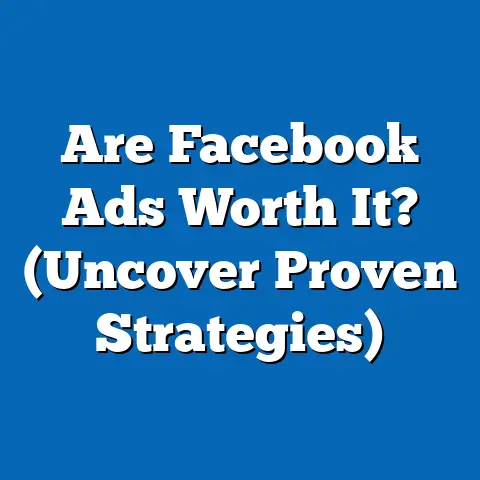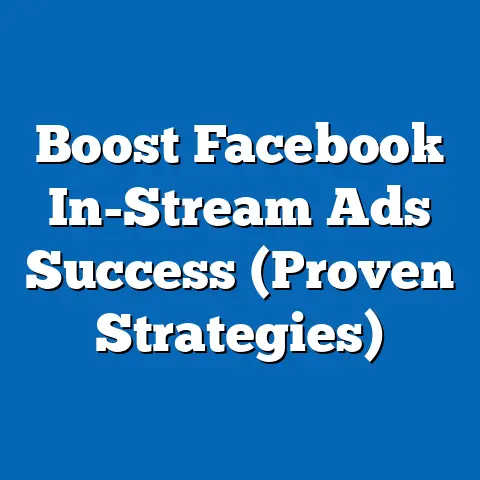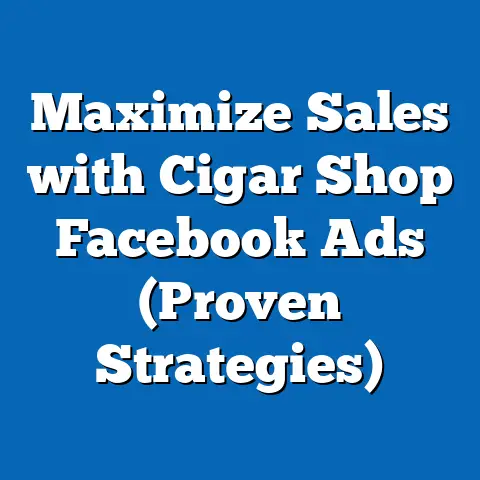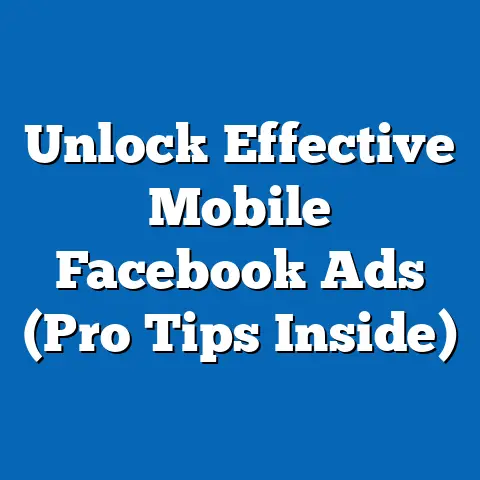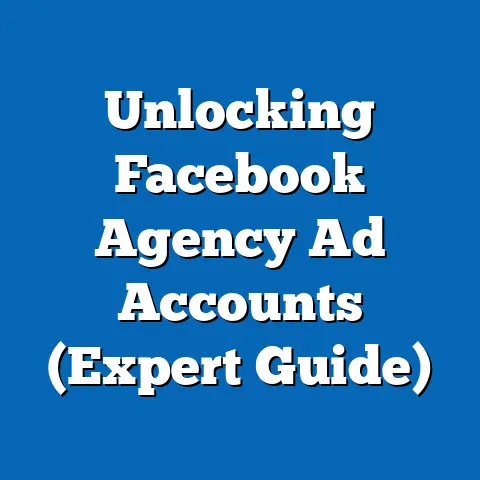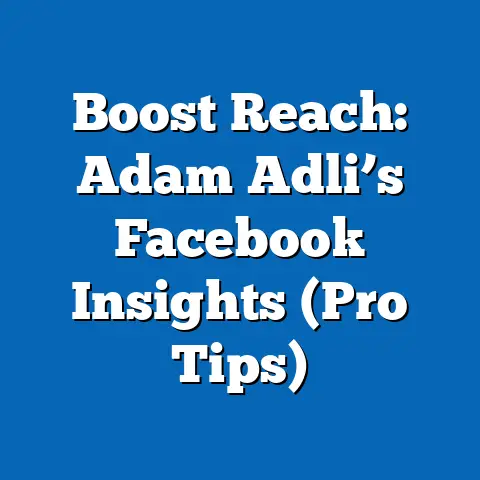YouTube vs. Facebook Video Ads: Key Insights (Pro Secrets)
Picture this: I’m at a bustling digital marketing conference, the kind where the air crackles with the energy of a thousand ideas colliding. The room is packed with marketers, entrepreneurs, and creatives, all buzzing about the latest trends in video advertising. Speakers are presenting case studies, showcasing the raw power of video to captivate audiences and drive results. You can hear the low hum of conversation, punctuated by bursts of laughter or applause.
In one corner, a small group is locked in a lively debate. The topic? The eternal question: YouTube versus Facebook video ads. Which platform reigns supreme? Which offers the best ROI? The tension is palpable as everyone seeks to unlock the secrets to cutting through the noise and grabbing attention in today’s crowded digital landscape.
The Rise of Video: Why It Matters
Video is no longer a “nice-to-have” in your marketing arsenal – it’s a necessity. Just think about your own online behavior. How many times have you scrolled past a wall of text to click on a captivating video? I know I have!
Here’s why video has become so dominant:
- Attention-Grabbing: Video inherently demands attention. Motion, sound, and visual storytelling create a more engaging experience than static images or text.
- High Information Retention: Studies show that viewers retain 95% of a message when they watch it in a video, compared to 10% when reading it in text. That’s a massive difference!
- Emotional Connection: Video allows you to connect with your audience on an emotional level through storytelling, music, and visual cues. This emotional connection builds trust and brand loyalty.
- Mobile-Friendly: With the majority of online consumption happening on mobile devices, video is perfectly suited for on-the-go viewing.
- Measurable Results: Video ad platforms offer robust analytics that allow you to track performance, measure ROI, and optimize your campaigns for better results.
The statistics speak for themselves. According to HubSpot, 87% of marketers say video has increased traffic to their website. And Wyzowl reports that 86% of businesses use video as a marketing tool, up from 63% in 2017.
In short, if you’re not leveraging video in your marketing strategy, you’re missing out on a huge opportunity to reach your target audience, build brand awareness, and drive conversions.
YouTube and Facebook: Two Titans of Video Advertising
Now that we understand the power of video, let’s zoom in on two of the biggest players in the video advertising game: YouTube and Facebook. Both platforms offer incredible reach, sophisticated targeting options, and robust analytics. But they also have distinct strengths and weaknesses that make them suitable for different marketing goals and target audiences.
YouTube: The Video Search Engine
YouTube is the undisputed king of online video. It’s the second largest search engine in the world (behind Google, its parent company), boasting over 2.5 billion monthly active users. People go to YouTube to learn, to be entertained, and to connect with their favorite creators.
Facebook: The Social Media Giant
Facebook, on the other hand, is the world’s largest social network, with nearly 3 billion monthly active users. People go to Facebook to connect with friends and family, discover new interests, and stay up-to-date on current events.
The Objective: Decoding the Best Fit
My aim in this article is to provide a comprehensive comparison of YouTube and Facebook video ads, equipping you with the knowledge and insights you need to make informed decisions about where to invest your marketing budget. I’ll delve into the nuances of each platform, exploring their audience demographics, ad formats, targeting options, engagement metrics, cost structures, and creative strategies.
By the end of this guide, you’ll have a clear understanding of the strengths and weaknesses of both platforms, enabling you to choose the best fit for your specific marketing goals and target audience. Let’s dive in!
Understanding the Platforms: A Deep Dive
To make informed decisions about your video advertising strategy, it’s crucial to understand the unique characteristics of each platform. Let’s explore YouTube and Facebook in detail.
YouTube: The Home of Long-Form Content and Intent-Based Search
YouTube’s history is a fascinating story of innovation and evolution. Founded in 2005, it quickly became the go-to platform for user-generated video content. Google acquired YouTube in 2006, and since then, it has grown into a global phenomenon, transforming the way people consume and share video.
Audience Demographics and Viewing Habits
YouTube’s audience is incredibly diverse, spanning all age groups, demographics, and interests. According to Statista, the platform reaches more 18-49 year-olds than any broadcast or cable TV network. However, there are some key trends to keep in mind:
- Younger Audience: YouTube is particularly popular among younger demographics, with a large percentage of users aged 18-34.
- Global Reach: YouTube has a massive global presence, with users from virtually every country in the world.
- Intent-Based Viewing: Unlike Facebook, where users often stumble upon videos while browsing their feeds, people typically go to YouTube with a specific intent in mind. They’re searching for tutorials, product reviews, entertainment, or information on a particular topic.
This intent-based viewing behavior is a key differentiator for YouTube. It means that you can target your video ads to users who are actively searching for content related to your product or service.
YouTube Ad Formats: A Diverse Range of Options
YouTube offers a variety of ad formats to suit different marketing goals and budgets. Here are some of the most common:
- TrueView In-Stream Ads: These ads play before, during, or after other videos. Viewers have the option to skip the ad after 5 seconds, which means you only pay when someone watches at least 30 seconds (or the entire ad if it’s shorter than 30 seconds). This is a popular choice for building brand awareness and driving website traffic. I’ve found this option to be very effective when the first 5 seconds are highly engaging.
- TrueView Discovery Ads: These ads appear in YouTube search results, on the YouTube homepage, and as related videos on watch pages. They consist of a thumbnail image and a short text description, and they’re designed to attract viewers who are actively searching for content related to your product or service. I personally use these to target very specific keywords.
- Bumper Ads: These are short, non-skippable video ads that play before, during, or after other videos. They’re typically 6 seconds in length and are designed to deliver a quick, memorable message. I use these often for brand reinforcement.
- Sponsored Cards: These are small, interactive cards that appear within videos and provide viewers with additional information about the product or service being advertised. They can be used to drive traffic to your website, promote other videos, or encourage viewers to take a specific action. I consider these to be a great way to drive clicks.
- Overlay Ads: These are banner ads that appear at the bottom of YouTube videos. They are less intrusive than in-stream ads and can be a good option for driving traffic to your website or promoting a specific offer. I have found that while they are less intrusive, they are also less impactful.
Takeaway: YouTube is a powerful platform for reaching a diverse audience with intent-based viewing habits. Its variety of ad formats allows you to tailor your campaigns to specific marketing goals, whether you’re looking to build brand awareness, drive website traffic, or generate leads.
Audience Demographics and Unique Features
Facebook’s audience is vast and diverse, spanning virtually every demographic group. However, there are some key characteristics to keep in mind:
- Broad Reach: Facebook has a massive user base, making it an ideal platform for reaching a wide audience.
- Diverse Demographics: While YouTube is particularly popular among younger demographics, Facebook has a more balanced age distribution.
- Social Connection: Facebook is all about social connection. Users go to the platform to connect with friends and family, share updates, and discover new interests.
Facebook’s unique features, such as Stories, in-stream ads, and Messenger ads, provide marketers with additional opportunities to engage with their target audience.
Facebook Ad Formats: Tailored for Social Engagement
Facebook offers a wide range of ad formats designed to capture attention and drive engagement on the social platform. Here are some of the most popular:
- In-Feed Video Ads: These ads appear directly in users’ news feeds, blending seamlessly with organic content. They’re a great way to reach a broad audience and drive brand awareness. I have seen great success with these when using captivating visuals.
- Stories Ads: These are short, vertical video ads that appear between users’ Stories. They’re a great way to reach a younger audience and drive engagement with interactive elements like polls and quizzes. I have found these to be very effective for short, punchy messages.
- Carousel Ads: These ads allow you to showcase multiple images or videos in a single ad unit. They’re a great way to highlight different aspects of your product or service or tell a compelling story. I personally use these for e-commerce clients.
- Collection Ads: These ads are designed for e-commerce businesses and allow you to showcase a collection of products in a visually appealing format. They’re a great way to drive traffic to your online store and increase sales.
- Instant Experience Ads: These ads provide a full-screen, immersive experience for users who click on your ad. They’re a great way to showcase your brand and tell a compelling story.
Takeaway: Facebook is a powerful platform for reaching a broad audience with hyper-targeting capabilities. Its diverse range of ad formats allows you to tailor your campaigns to specific marketing goals, whether you’re looking to build brand awareness, drive website traffic, or generate leads.
Engagement Metrics and Performance: Measuring What Matters
Understanding how your video ads are performing is crucial for optimizing your campaigns and maximizing your ROI. Let’s explore the key engagement metrics and performance indicators for both YouTube and Facebook.
YouTube: Diving Deep into Watch Time and Audience Retention
YouTube Analytics provides a wealth of data about how viewers are interacting with your video ads. Here are some of the most important metrics to track:
- View Rate: This is the percentage of people who see your ad and choose to watch it. A high view rate indicates that your ad is relevant and engaging to your target audience.
- Watch Time: This is the total amount of time that viewers spend watching your video ads. Longer watch times indicate that your ad is captivating and holding viewers’ attention. I always aim for at least 50% watch time.
- Audience Retention: This metric shows you how long viewers are watching your video ads. It can help you identify the points in your video where viewers are dropping off, allowing you to optimize your content for better engagement.
- Engagement Metrics: These include likes, comments, shares, and subscriptions. High engagement rates indicate that your ad is resonating with your audience and encouraging them to take action.
- Click-Through Rate (CTR): This is the percentage of people who see your ad and click on the call-to-action (CTA) to visit your website or take another desired action. A high CTR indicates that your ad is compelling and relevant to your target audience.
Tools for Measuring Success
YouTube Analytics is your primary tool for tracking video ad performance. It provides detailed data on all of the metrics listed above, as well as insights into your audience demographics, traffic sources, and more.
In addition to YouTube Analytics, you can also use Google Analytics to track the behavior of users who click on your video ads and visit your website. This can help you understand how your video ads are contributing to your overall marketing goals.
Takeaway: Focus on optimizing your video ads for longer watch times and higher audience retention. Use YouTube Analytics to identify the points in your video where viewers are dropping off and make adjustments to improve engagement.
Facebook: Tracking Clicks, Shares, and Conversions
Facebook Insights provides a comprehensive overview of your video ad performance. Here are some of the key metrics to monitor:
- Click-Through Rate (CTR): This is the percentage of people who see your ad and click on the CTA. A high CTR indicates that your ad is relevant and compelling to your target audience.
- Shares: This metric measures how many people are sharing your video ad with their friends and family. Shares are a great way to increase your reach and build brand awareness.
- Comments: This metric measures how many people are leaving comments on your video ad. Comments are a great way to gauge audience sentiment and engage in conversations with your target audience.
- Conversions: This metric measures how many people are taking a desired action after seeing your video ad, such as visiting your website, filling out a form, or making a purchase. Conversions are the ultimate measure of success for many video ad campaigns.
- Cost-Per-Click (CPC): This is the amount you pay each time someone clicks on your video ad. A low CPC indicates that your ad is efficient and cost-effective.
Facebook Insights and Other Tracking Tools
Facebook Insights is your primary tool for tracking video ad performance on Facebook. It provides detailed data on all of the metrics listed above, as well as insights into your audience demographics, ad delivery, and more.
You can also use Facebook Pixel to track the behavior of users who click on your video ads and visit your website. This can help you understand how your video ads are contributing to your overall marketing goals, such as lead generation and sales.
Takeaway: Focus on optimizing your video ads for higher click-through rates, shares, and conversions. Use Facebook Insights to identify the elements of your ad that are driving engagement and make adjustments to improve performance.
Targeting and Audience Reach: Finding Your Ideal Viewer
Effective targeting is essential for maximizing the impact of your video ads. Let’s explore the targeting options available on YouTube and Facebook.
YouTube: Leveraging Intent and Keywords
YouTube’s targeting options are based on user intent and search behavior. Here are some of the most effective targeting methods:
Search engine optimization (SEO) is crucial for maximizing the visibility of your video ads on YouTube. By optimizing your video titles, descriptions, and tags with relevant keywords, you can increase your chances of reaching your target audience.
Takeaway: Focus on targeting your video ads to users who are actively searching for content related to your product or service. Optimize your video titles, descriptions, and tags with relevant keywords to improve your SEO and increase your reach.
Facebook: Unleashing the Power of Hyper-Targeting
Facebook’s targeting capabilities are incredibly powerful, allowing you to reach a highly specific audience based on a wide range of factors. Here are some of the most effective targeting options:
- Demographics: Target your video ads to users based on their age, gender, location, education, relationship status, and other demographic characteristics.
- Interests: Target your video ads to users who have expressed an interest in specific topics, brands, or activities.
- Behaviors: Target your video ads to users based on their online behavior, such as their purchase history, website visits, and app usage.
- Lookalike Audiences: Create lookalike audiences based on your existing customers or website visitors. This is a great way to reach new people who are similar to your best customers. I have personally seen great results with lookalike audiences.
- Retargeting: Retarget your video ads to users who have previously interacted with your website or Facebook page. This is a great way to re-engage people who have already shown an interest in your product or service.
Leveraging User-Generated Data for Ad Targeting
Facebook’s vast trove of user-generated data provides marketers with unparalleled targeting opportunities. By leveraging this data, you can reach a highly specific audience with personalized messages that resonate with their interests and needs.
Takeaway: Take advantage of Facebook’s hyper-targeting capabilities to reach a highly specific audience with personalized messages. Create lookalike audiences based on your existing customers and retarget users who have previously interacted with your brand.
Cost Analysis: Understanding the Investment
Understanding the cost structures of YouTube and Facebook video ads is crucial for maximizing your ROI. Let’s explore the average costs and budgeting strategies for each platform.
YouTube: Navigating Bidding Strategies and ROI
The cost of YouTube ads can vary depending on several factors, including your bidding strategy, target audience, ad format, and the overall competition for ad space. Here are some general guidelines:
- Cost-Per-View (CPV): This is the most common bidding strategy for YouTube ads. You pay each time someone watches your ad for at least 30 seconds (or the entire ad if it’s shorter than 30 seconds). The average CPV for YouTube ads is typically between $0.10 and $0.30.
- Cost-Per-Click (CPC): This bidding strategy is used for TrueView Discovery ads. You pay each time someone clicks on your ad to visit your website or take another desired action. The average CPC for YouTube ads is typically between $0.50 and $2.00.
- Target CPM (Cost-Per-Mille): This bidding strategy allows you to set a target cost for every 1,000 impressions of your ad. YouTube will then optimize your bids to try to reach your target CPM.
Factors Influencing YouTube Ad Pricing
Several factors can influence the cost of your YouTube ads, including:
- Target Audience: Targeting a highly competitive audience can drive up the cost of your ads.
- Ad Format: Different ad formats have different pricing structures. For example, TrueView In-Stream ads typically have a lower CPV than TrueView Discovery ads.
- Bidding Strategy: Your bidding strategy can significantly impact the cost of your ads. Experiment with different bidding strategies to find the one that works best for your budget and goals.
- Ad Quality: YouTube rewards high-quality ads with lower costs and better performance. Make sure your ads are engaging, relevant, and well-produced.
Takeaway: Experiment with different bidding strategies and ad formats to find the most cost-effective way to reach your target audience on YouTube. Focus on creating high-quality ads that are engaging and relevant to your target audience.
Facebook: Decoding CPC and Budgeting Strategies
The cost of Facebook video ads can also vary depending on several factors, including your bidding strategy, target audience, ad placement, and the overall competition for ad space. Here are some general guidelines:
- Cost-Per-Click (CPC): This is the most common bidding strategy for Facebook ads. You pay each time someone clicks on your ad to visit your website or take another desired action. The average CPC for Facebook video ads is typically between $0.50 and $2.00.
- Cost-Per-Mille (CPM): This bidding strategy allows you to pay for every 1,000 impressions of your ad. CPM is a good option if you’re focused on building brand awareness and reaching a large audience.
- Cost-Per-Action (CPA): This bidding strategy allows you to pay only when someone takes a specific action after seeing your ad, such as filling out a form or making a purchase. CPA is a good option if you’re focused on generating leads or driving sales.
Maximizing Ad Spend Effectiveness on Facebook
To maximize the effectiveness of your ad spend on Facebook, consider the following budgeting strategies:
- Set a Daily Budget: Set a daily budget for your ad campaigns to ensure that you don’t overspend.
- Monitor Your Performance: Regularly monitor your ad performance and make adjustments as needed to improve your ROI.
- Experiment with Different Ad Placements: Test different ad placements to see which ones are most effective for reaching your target audience.
- Use Retargeting: Retarget your ads to users who have previously interacted with your website or Facebook page. This is a great way to re-engage people who have already shown an interest in your product or service.
Takeaway: Experiment with different bidding strategies and ad placements to find the most cost-effective way to reach your target audience on Facebook. Use retargeting to re-engage people who have already shown an interest in your brand.
Creative Strategies for Video Ads: Captivating Your Audience
Creating compelling video ads is essential for capturing attention and driving engagement on both YouTube and Facebook. Let’s explore some best practices and successful case studies for each platform.
YouTube: Crafting Engaging Content for Intent-Based Viewers
To create successful YouTube video ads, focus on delivering valuable content that resonates with your target audience. Here are some best practices:
- Start with a Hook: Grab viewers’ attention in the first few seconds of your ad with a compelling hook. This could be a question, a surprising statistic, or a visually stunning image.
- Provide Value: Offer viewers something of value in your ad, such as information, entertainment, or a solution to a problem.
- Keep it Concise: Keep your video ads short and to the point. Viewers are more likely to watch a shorter ad than a longer one.
- Use a Clear Call-to-Action: Tell viewers what you want them to do after watching your ad, such as visiting your website, subscribing to your channel, or making a purchase.
- Optimize for Mobile: Make sure your video ads are optimized for mobile viewing. This means using clear visuals, large text, and a vertical aspect ratio.
Case Studies: Learning from Success
- Dollar Shave Club: Their viral video ad, “Our Blades Are F***ing Great,” is a classic example of how to use humor and authenticity to capture attention and drive sales.
- Blendtec: Their “Will It Blend?” series is a creative and entertaining way to showcase the power of their blenders.
- Old Spice: Their “The Man Your Man Could Smell Like” campaign is a memorable and engaging way to promote their brand.
Takeaway: Focus on creating valuable content that resonates with your target audience. Use a clear call-to-action and optimize your ads for mobile viewing.
Facebook: Designing Ads for Social Engagement
To create successful Facebook video ads, focus on capturing attention and driving engagement in a social environment. Here are some best practices:
- Use Visually Appealing Content: Use high-quality images and videos that are visually appealing and relevant to your target audience.
- Tell a Story: Use your video ads to tell a compelling story that resonates with your target audience.
- Keep it Short and Sweet: Facebook users are often scrolling quickly through their feeds, so it’s important to keep your video ads short and to the point.
- Use Captions: Many Facebook users watch videos with the sound off, so it’s important to use captions to convey your message.
- Encourage Engagement: Encourage viewers to like, comment, and share your video ads. This will help to increase your reach and build brand awareness.
Insights from Brands Mastering Facebook Video Advertising
- GoPro: They use user-generated content to showcase the capabilities of their cameras and inspire viewers to capture their own adventures.
- Airbnb: They use video ads to tell stories about their hosts and guests, creating an emotional connection with their audience.
- BuzzFeed: They create short, engaging video ads that are designed to be shared on social media.
Takeaway: Focus on creating visually appealing content that tells a compelling story. Use captions to convey your message and encourage viewers to engage with your ads.
Comparative Case Studies: Learning from Real-World Examples
Let’s examine some side-by-side comparisons of successful video ad campaigns on YouTube and Facebook to glean valuable insights.
Case Study 1: Product Demonstration
- YouTube: A software company creates a detailed tutorial showcasing the features and benefits of their product. The ad targets users searching for “software tutorial” and related keywords.
- Facebook: The same company creates a shorter, more visually appealing video highlighting the key benefits of their software. The ad targets users who have expressed an interest in software or technology.
Analysis: The YouTube ad focuses on providing in-depth information to users who are actively searching for a solution. The Facebook ad focuses on capturing attention and generating interest among a broader audience.
Case Study 2: Brand Awareness
- YouTube: A beverage company creates a series of short, humorous video ads featuring a popular influencer. The ads target users who are interested in the influencer and related topics.
- Facebook: The same company creates a visually stunning video ad showcasing their brand and products. The ad targets users based on their demographics and interests.
Analysis: The YouTube ad leverages the popularity of an influencer to reach a targeted audience. The Facebook ad focuses on building brand awareness among a broader audience.
Case Study 3: E-Commerce Promotion
- YouTube: An e-commerce company creates a video ad featuring a product review by a trusted expert. The ad targets users searching for “product review” and related keywords.
- Facebook: The same company creates a carousel ad showcasing multiple products with a clear call-to-action to “Shop Now.” The ad targets users who have previously visited their website or Facebook page.
Analysis: The YouTube ad focuses on providing social proof and building trust with potential customers. The Facebook ad focuses on driving direct sales and re-engaging users who have already shown an interest in their products.
Insights Across Industries
Different industries leverage each platform effectively based on their specific goals and target audience. For example, B2B companies often find success on YouTube by creating informative tutorials and product demonstrations. E-commerce companies often find success on Facebook by creating visually appealing product ads and using retargeting to drive sales.
Takeaway: Analyze successful video ad campaigns in your industry to identify best practices and strategies that you can apply to your own campaigns. Consider your specific goals and target audience when choosing between YouTube and Facebook.
Conclusion: Charting Your Video Advertising Path
We’ve covered a lot of ground in this guide, exploring the intricacies of YouTube and Facebook video ads. Let’s recap the key insights:
- YouTube: Ideal for reaching an intent-based audience with longer-form content and targeted keywords.
- Facebook: Ideal for reaching a broad audience with hyper-targeting capabilities and visually appealing content.
- Engagement Metrics: Track view rates, watch time, and engagement metrics on YouTube. Track click-through rates, shares, and conversions on Facebook.
- Cost Analysis: Experiment with different bidding strategies and ad formats to find the most cost-effective way to reach your target audience on both platforms.
- Creative Strategies: Focus on creating valuable content that resonates with your target audience on YouTube. Focus on creating visually appealing content that tells a compelling story on Facebook.
A Final Thought: Experimentation is Key
Ultimately, the best way to determine which platform is right for your business is to experiment with both YouTube and Facebook video ads. Test different ad formats, targeting options, and creative strategies to see what works best for your specific goals and target audience.
Don’t be afraid to try new things and push the boundaries of what’s possible. The world of video advertising is constantly evolving, so it’s important to stay up-to-date on the latest trends and best practices.
By understanding the strengths and weaknesses of both platforms and continuously optimizing your campaigns, you can unlock the full potential of video advertising and achieve your marketing goals. Now go forth and create some amazing video ads!

